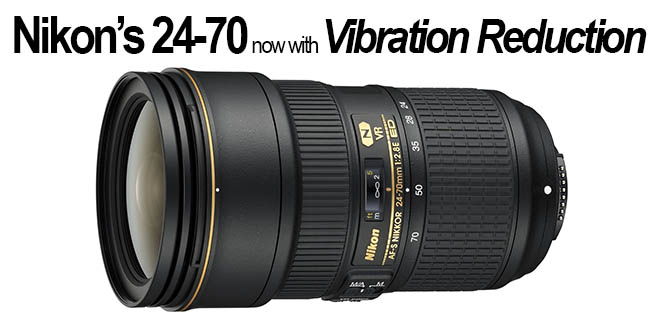 The Nikon 24-70 2.8 without vibration reduction has been a standard in many photographers’ gear bags since it was released almost a decade ago. In fact, it’s still Amazon’s #1 most popular selling SLR lens. Now, the 24-70 is getting an upgrade from Nikon in the form of Vibration Reduction.
The Nikon 24-70 2.8 without vibration reduction has been a standard in many photographers’ gear bags since it was released almost a decade ago. In fact, it’s still Amazon’s #1 most popular selling SLR lens. Now, the 24-70 is getting an upgrade from Nikon in the form of Vibration Reduction.
Here are the highlights from Nikon:
- Fast f/2.8 constant aperture with an electromagnetic diaphragm
- Sensational image quality and sharpness with virtually no distortion
- 4 stops of Vibration Reduction for handheld and low-light shooting
- Nonstick glass makes it easier to wipe off water, dirt and smudges
- Evolution of Nikon’s legendary 24-70mm workhorse
Nikon 24-70 VR – Is it worth upgrading?
The option for vibration reduction has been a popular one for Nikon’s longer zoom lens, the 70-200 VR2 for some time. Even though this is a significantly shorter zoom lens, I would expect that many photographers, especially natural light photographers or those not using flash on a regular basis, would find the 4 extra stops of sharpness to be quite beneficial.
It’s likely that we’ll see a discount on the older version of the 24-70 in the future, but that hasn’t happened yet. Because Nikon is keeping the price high, photographers looking to upgrade to the new Nikon 24-70 VR should get a solid return from selling their non-VR 24-70.
Nikon 24-70 VR Price & Discounts
At the time of release, there will not be any discounts available. At the time of publishing, the price of the new Nikon 24-70 VR is just shy of $2,400. Check the most current price of the Nikon 24-70 VR here.
Nikon 24-70 VR for Video
For video, vibration reduction can be helpful or it can produce strange results. If you don’t have the most rock-steady tripod and you’re filming a stationary subject, vibration reduction can help steady the shot from wind gusts or other environmental factors. On the other hand, panning, tilting, or other camera movement with vibration reduction can produce some very non-cinimatic results. The camera/lens are trying to correct for anything non-stabilized, so shots involving camera movement can/will suffer when VR is switched on.
Though, as someone who uses a Glidecam HD-4000 with a Nikon D810 and a non-VR 24-70, I’m curious what the results would look like. Sometimes even a shaky arm can produce small vibrations in the footage, and it could be harder to detect the weird VR issues while gliding. We’ll see if we can get our hands on one to review for you soon.
 Nikon DSLR Video Videography News, Tutorials, Reviews, and Information
Nikon DSLR Video Videography News, Tutorials, Reviews, and Information